Chap_29长期中的货币与物价
- 格式:ppt
- 大小:1.40 MB
- 文档页数:62
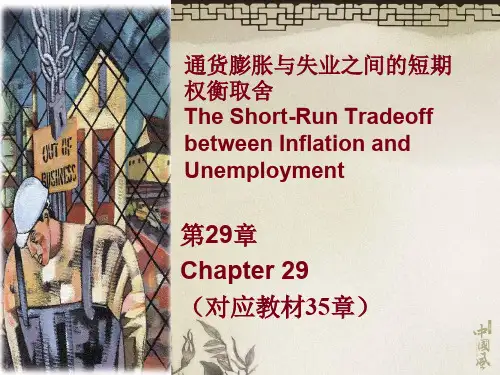

SOLUTIONS TO TEXT PROBLEMS:Quick Quizzes1. The three functions of money are: (1) medium of exchange; (2) unit of account; and (3) store ofvalue. Money is used as a medium of exchange because money is the item people use topurchase goods and services. Money is used as a unit of account because it is the yardstickpeople use to post prices and record debts. Money is used as a store of value because it is an item people use to transfer purchasing power from the present to the future.2. The primary responsibilities of the Federal Reserve are to regulate banks, ensuring the health ofthe banking system, and to control the quantity of money that is made available in the economy.If the Fed wants to increase the supply of money, it usually does so by creating dollars and using them to purchase government bonds from the public in the nation’s bond markets.3. Banks create money when they make loans and hold a fraction of the amount of the loans inreserves, resulting in an expansion of both money and credit in the economy. If the Fed wanted to use all three of its tools to decrease the money supply, it would: (1) sell government bonds from its portfolio in the open market to reduce the number of dollars in circulation; (2) increase reserve requirements to reduce the money created by banks; and (3) increase the discount rate to discourage banks from borrowing reserves from the Fed.Questions for Review1. Money is different from other assets in the economy because it is the most liquid asset available.Other assets vary widely in their liquidity.2. Commodity money is money with intrinsic value, like gold, which can be used for purposes otherthan as a medium of exchange. Fiat money is money without intrinsic value; it has no value other than its use as a medium of exchange. Our economy today uses fiat money.3. Demand deposits are balances in bank accounts that depositors can access on demand simply bywriting a check. They should be included in the stock of money because they can be as a medium of exchange.4. The Federal Open Market Committee (FOMC) is responsible for setting monetary policy in theUnited States. The FOMC consists of the seven members of the Federal Reserve Board ofGovernors and five of the 12 presidents of Federal Reserve Banks. Members of the Board ofGovernors are appointed by the president of the United States and confirmed by the U.S. Senate.The presidents of the Federal Reserve Banks are chosen by each bank’s board of directors.5. If the Fed wants to increase the supply of money with open-market operations, it purchases U.S.government bonds from the public on the open market. The purchase increases the number of dollars in the hands of the public, thus raising the money supply.6. Banks do not hold 100 percent reserves because it is more profitable to use the reserves to makeloans, which earn interest, instead of leaving the money as reserves, which earn no interest. The amount of reserves banks hold is related to the amount of money the banking system createsthrough the money multiplier. The smaller the fraction of reserves banks hold, the larger themoney multiplier, since each dollar of reserves is used to create more money.7. The discount rate is the interest rate on loans that the Federal Reserve makes to banks. If the Fedraises the discount rate, fewer banks will borrow from the Fed, so banks' reserves will be lower, and thus the money supply will be lower.8. Reserve requirements are regulations on the minimum amount of reserves that banks must holdagainst deposits. An increase in reserve requirements raises the reserve ratio, lowers the money multiplier, and decreases the money supply.9. The Fed cannot control the money supply perfectly because: (1) the Fed does not control theamount of money that households choose to hold as deposits in banks; and (2) the Fed does not control the amount that bankers choose to lend. The actions of households and banks affect the money supply in ways the Fed cannot perfectly control or predict.Problems and Applications1. a. A U.S. penny is money in the U.S. economy because it is used as a medium of exchange tobuy goods or services, it serves as a unit of account because prices in stores are listed interms of dollars and cents, and it serves as a store of value for anyone who holds it overtime.b. A Mexican peso is not money in the U.S. economy, because it is not used as a medium ofexchange, and prices are not given in terms of pesos, so it is not a unit of account. Itcould serve as a store of value, though.c. A Picasso painting is not money, because you cannot exchange it for goods or services, andprices are not given in terms of Picasso paintings. It does, however, serve as a store ofvalue.d. A plastic credit card is similar to money, but represents deferred payment, rather thatimmediate payment. So credit cards do not fully represent the medium of exchangefunction of money, nor are they really stores of value, since they represent short-termloans rather than being an asset like currency.2. a. It would be difficult to run the economy using the "Swopper's Column" instead of moneybecause it requires finding a double coincidence of wants. Money works efficientlybecause it requires satisfying people's needs on just one side of each transaction; you buysomething for money and sell something else for money. With money, you do not have tobuy something from someone who wants an item you're selling.b. The "Swopper's Column" probably exists so that people can avoid paying taxes on thingsthey buy and sell.3. For an asset to be useful as a medium of exchange, it must be widely accepted (so all transactionscan be made in terms of it), recognized easily as money (so people can perform transactions easily and quickly), divisible (so people can provide change), and difficult to counterfeit (so people will not print their own money). That is why nearly all countries use paper money with fancy designs for larger denominations and coins for smaller denominations.For an asset to be useful as a store of value, it must be something that maintains its value over time and something that can be used directly to buy goods and services or sold when money is needed.In addition to currency, financial assets (like stocks and bonds) and physical assets (like real estate and art) make good stores of value.4. a. If there were an easy way to make limestone wheels, the people on Yap would makeadditional wheels as long as the monetary value of the wheels was greater than the cost ofproducing the wheels. The result would be that people would make their own money, sothere would be too much money produced. Most likely, people would stop accepting thewheels as money and switch to some other asset as a medium of exchange.b. If someone in the United States discovered an easy way to counterfeit hundred-dollar bills,they could flood the country with counterfeit currency, thus reducing its value. The resultmight be a switch to a different type of currency.5. Many answers are possible.6. When your uncle repays a $100 loan from Tenth National Bank (TNB) by writing a check from hisTNB checking account, the result is a change in the assets and liabilities of both your uncle and TNB, as shown in these T-accounts:By paying off the loan, your uncle simply eliminated the outstanding loan using the assets in his checking account. Your uncle's wealth has not changed; he simply has fewer assets and fewerliabilities.7. a. Here is BSB's T-account:b. When BSB's largest depositor withdraws $10 million in cash and BSB reduces its loansoutstanding to maintain the same reserve ratio, its T-account is now:c. Since BSB is cutting back on its loans, other banks will find themselves short of reservesand they may also cut back on their loans as well.d. BSB may find it difficult to cut back on its loans immediately, since it cannot force people topay off loans. Instead, it can stop making new loans. But for a time it might find itselfwith more loans than it wants. It could try to attract additional deposits to get additionalreserves, or borrow from another bank or from the Fed.8. If you take $100 that you held as currency and put it into the banking system, then the totalamount of deposits in the banking system increases by $1,000, since a reserve ratio of 10 percent means the money multiplier is 1/.10 = 10. Thus the money supply increases by $900, sincedeposits increase by $1,000 but currency declines by $100.9. With a required reserve ratio of 10 percent, the money multiplier could be as high as 1/.10 = 10, ifbanks hold no excess reserves and people do not keep some additional currency. So themaximum increase in the money supply from a $10 million open-market purchase is $100 million.The smallest possible increase is $10 million if all of the money is held by banks as excess reserves.10. a. If the required reserve ratio is 5 percent, then First National Bank's required reserves are$500,000 x .05 = $25,000. Since the bank’s total reserves are $100,000, it has excessreserves of $75,000.b. With a required reserve ratio of 5 percent, the money multiplier is 1/.05 = 20. If FirstNational lends out its excess reserves of $75,000, the money supply will eventuallyincrease by $75,000 x 20 = $1,500,000.11. a. With a required reserve ratio of 10 percent and no excess reserves, the money multiplier is1/.10 = 10. If the Fed sells $1 million of bonds, reserves will decline by $1 million and themoney supply will contract by 10 x $1 million = $10 million.b. Banks might wish to hold excess reserves if they need to hold the reserves for theirday-to-day operations, such as paying other banks for customers' transactions, makingchange, cashing paychecks, and so on. If banks increase excess reserves such that thereis no overall change in the total reserve ratio, then the money multiplier does not changeand there is no effect on the money stock.12. a. With banks holding only required reserves of 10 percent, the money multiplier is 1/.10 =10. Since reserves are $100 billion, the money stock is 10 x $100 billion = $1,000 billion.b. If the required reserve ratio is raised to 20 percent, the money multiplier declines to 1/.20= 5. With reserves of $100 billion, the money stock would decline to $500 billion, adecline of $500 billion. Reserves would be unchanged.13. a. If people hold all money as currency, the quantity of money is $2,000.b. If people hold all money as demand deposits at banks with 100 percent reserves, thequantity of money is $2,000.c. If people have $1,000 in currency and $1,000 in demand deposits, the quantity of money is$2,000.d. If banks have a reserve ratio of 10 percent, the money multiplier is 1/.10 = 10. So ifpeople hold all money as demand deposits, the quantity of money is 10 x $2,000 =$20,000.e. If people hold equal amounts of currency (C) and demand deposits (D) and the moneymultiplier for reserves is 10, then two equations must be satisfied:(1) C = D, so that people have equal amounts of currency and demand deposits; and (2)10 x ($2,000 - C) = D, so that the money multiplier (10) times the number of dollar billsthat are not being held by people ($2,000 - C) equals the amount of demand deposits (D).Using the first equation in the second gives 10 x ($2,000 - D) = D, or $20,000 - 10 D = D, or $20,000 = 11 D, so D = $1,818.18. Then C = $1,818.18. The quantity of money is C + D = $3,636.36.。
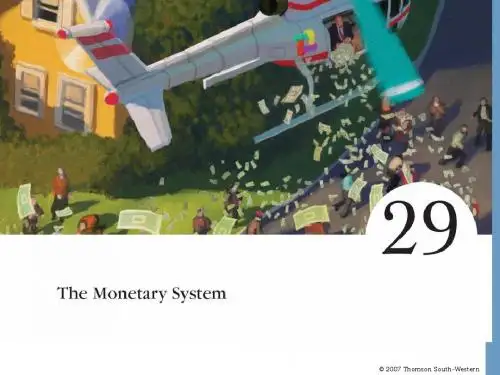
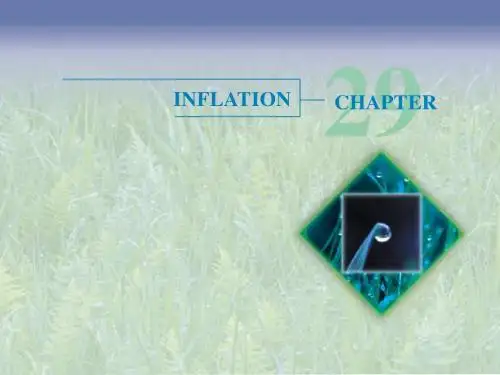
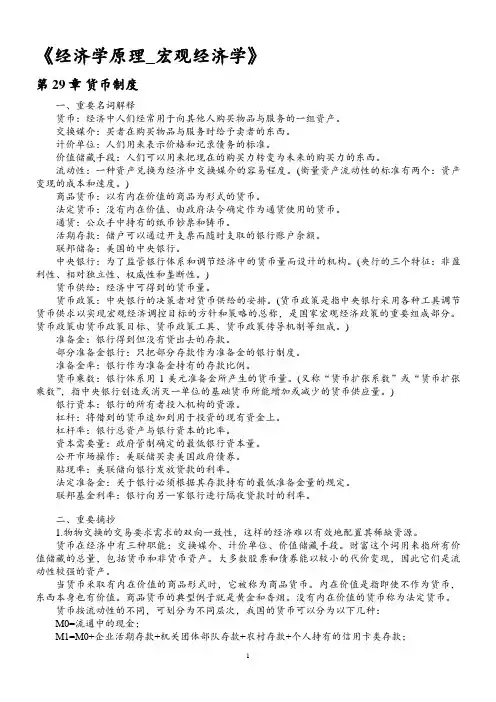
《经济学原理_宏观经济学》第29章货币制度一、重要名词解释货币:经济中人们经常用于向其他人购买物品与服务的一组资产。
交换媒介:买者在购买物品与服务时给予卖者的东西。
计价单位:人们用来表示价格和记录债务的标准。
价值储藏手段:人们可以用来把现在的购买力转变为未来的购买力的东西。
流动性:一种资产兑换为经济中交换媒介的容易程度。
(衡量资产流动性的标准有两个:资产变现的成本和速度。
)商品货币:以有内在价值的商品为形式的货币。
法定货币:没有内在价值、由政府法令确定作为通货使用的货币。
通货:公众手中持有的纸币钞票和铸币。
活期存款:储户可以通过开支票而随时支取的银行账户余额。
联邦储备:美国的中央银行。
中央银行:为了监管银行体系和调节经济中的货币量而设计的机构。
(央行的三个特征:非盈利性、相对独立性、权威性和垄断性。
)货币供给:经济中可得到的货币量。
货币政策:中央银行的决策者对货币供给的安排。
(货币政策是指中央银行采用各种工具调节货币供求以实现宏观经济调控目标的方针和策略的总称,是国家宏观经济政策的重要组成部分。
货币政策由货币政策目标、货币政策工具、货币政策传导机制等组成。
)准备金:银行得到但没有贷出去的存款。
部分准备金银行:只把部分存款作为准备金的银行制度。
准备金率:银行作为准备金持有的存款比例。
货币乘数:银行体系用1美元准备金所产生的货币量。
(又称“货币扩张系数”或“货币扩张乘数”,指中央银行创造或消灭一单位的基础货币所能增加或减少的货币供应量。
) 银行资本:银行的所有者投入机构的资源。
杠杆:将借到的货币追加到用于投资的现有资金上。
杠杆率:银行总资产与银行资本的比率。
资本需要量:政府管制确定的最低银行资本量。
公开市场操作:美联储买卖美国政府债券。
贴现率:美联储向银行发放贷款的利率。
法定准备金:关于银行必须根据其存款持有的最低准备金量的规定。
联邦基金利率:银行向另一家银行进行隔夜贷款时的利率。
二、重要摘抄1.物物交换的交易要求需求的双向一致性,这样的经济难以有效地配置其稀缺资源。
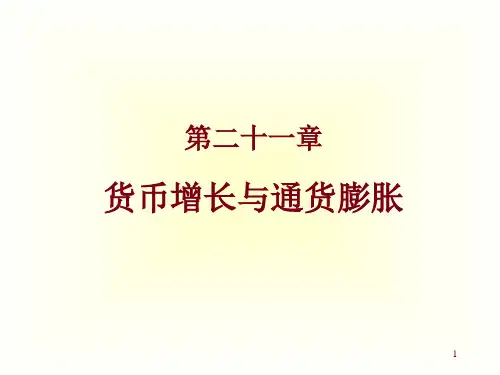
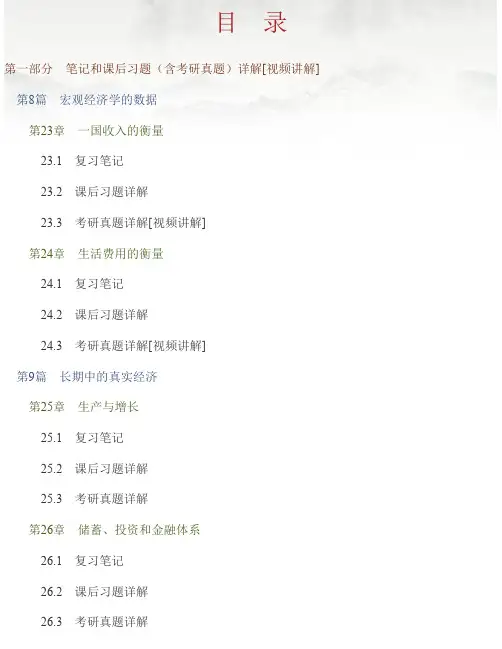
目 录第一部分 笔记和课后习题(含考研真题)详解[视频讲解]第8篇 宏观经济学的数据第23章 一国收入的衡量23.1 复习笔记23.2 课后习题详解23.3 考研真题详解[视频讲解]第24章 生活费用的衡量24.1 复习笔记24.2 课后习题详解24.3 考研真题详解[视频讲解]第9篇 长期中的真实经济第25章 生产与增长25.1 复习笔记25.2 课后习题详解25.3 考研真题详解第26章 储蓄、投资和金融体系26.1 复习笔记26.2 课后习题详解26.3 考研真题详解第27章 基本金融工具27.1 复习笔记27.2 课后习题详解27.3 考研真题详解[视频讲解]第28章 失 业28.1 复习笔记28.2 课后习题详解28.3 考研真题详解[视频讲解]第10篇 长期中的货币与物价第29章 货币制度29.1 复习笔记29.2 课后习题详解29.3 考研真题详解[视频讲解]第30章 货币增长与通货膨胀30.1 复习笔记30.2 课后习题详解30.3 考研真题详解[视频讲解]第11篇 开放经济的宏观经济学第31章 开放经济的宏观经济学:基本概念31.1 复习笔记31.2 课后习题详解[视频讲解]31.3 考研真题详解第32章 开放经济的宏观经济理论32.1 复习笔记32.2 课后习题详解[视频讲解]32.3 考研真题详解[视频讲解]第12篇 短期经济波动第33章 总需求与总供给33.1 复习笔记33.2 课后习题详解33.3 考研真题详解[视频讲解]第34章 货币政策和财政政策对总需求的影响34.1 复习笔记34.2 课后习题详解34.3 考研真题详解[视频讲解]第35章 通货膨胀与失业之间的短期权衡取舍35.1 复习笔记35.2 课后习题详解35.3 考研真题详解[视频讲解]第13篇 最后的思考第36章 宏观经济政策的六个争论问题36.1 复习笔记36.2 课后习题详解36.3 考研真题详解[视频讲解]第二部分 模拟试题及详解曼昆《经济学原理(宏观经济学分册)》(第6版)模拟试题及详解(一)曼昆《经济学原理(宏观经济学分册)》(第6版)模拟试题及详解(二)第一部分 笔记和课后习题(含考研真题)详解[视频讲解]第8篇 宏观经济学的数据第23章 一国收入的衡量23.1 复习笔记1.经济的收入与支出在一国的宏观经济中,收入必定等于支出。
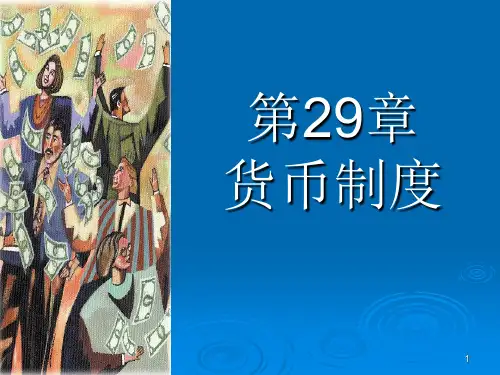
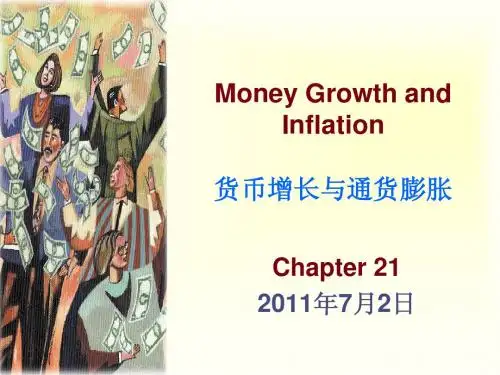
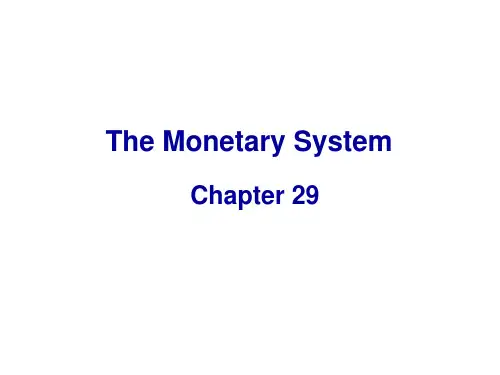

第29章货币制度第29章货币制度一、名词解释1.通货2.交换媒介3.流动性4.商品货币5.法定货币6.准备金7.准备金率8.货币乘数9.公开市场操作10.联邦基金利率11.计价单位12.财富13.货币存量二、选择题1.以下哪一项不是货币的职能________ A.计价单位B.价值储藏手段C.防止通货膨胀D.交换媒介2.下列哪一个是法定货币的例子________ A.黄金B.美元纸币C.银元D.战俘营中的香烟3.商品货币________A.没有内在价值B.有内在价值C.只能在美国使用D.作为支持法定货币的准备金使用4.银行的法定准备金是________的一个固定百分比。
A.贷款B.资产C.存款D.政府债券5.如果法定准备金是25%,那么货币乘数是________A.0.25B.4C.5D.256.贴现率是________A.美联储向准备金支付的利率B.银行向公众存款支付的利率C.美联储向银行发放贷款收取的利率D.当公众向银行借款时支付的利率7.假设央行购买了你的1000元政府债券,如果你把这1000元全部存入银行,且法定准备金率是20%,那么央行的行为会引起货币供给总量多大的潜在变动?A.1000元B.4000元C.5000元D.08.假设Joe把在A银行的1000美元活期存款转到B银行。
如果法定准备金是10%,那么由于Joe的行为,活期存款的潜在变动是________。
A.1000元B.4000元C.5000元D.09.以下________政策组合会一致地起到增加货币供给的作用。
A.出售政府债券,降低法定准备金,降低贴现率B.出售政府债券,提高法定准备金,提高贴现率C.购买政府债券,提高法定准备金,降低贴现率D.购买政府债券,降低法定准备金,降低贴现率10.假设央行购买了一个人的政府债券。
这个人把自己的销售收入都存入他的开户银行。
如果银行把一部分存款作为超额准备金,那么货币供给将________。
第29章货币制度·本章介绍货币制度,为以后的分析提供背景知识。
主要探讨以下内容:第一,货币的含义第二,介绍美国的中央银行-美联储第三,银行如何影响货币供给第四,货币政策工具货币的含义·货币-经济中一组资产-人们经常用其向其他人购买物品与劳务·货币的职能-交换媒介-计价单位-价值储藏·交换媒介-买者在购买物品与劳务时给予卖者的东西·计价单位-人们用来表示价格和记录债务的标准·价值储藏-人们可以用来把现在的购买力转变为未来的购买力的东西·流动性-一种资产兑换为经济中交换媒介的容易程度货币的种类·商品货币-以有内在价值的商品为形式的货币·内在价值-即使不作为货币,东西本身也有价值·金本位-用黄金作为货币-或者用可以随时兑换为黄金的纸币·法定货币-没有内在价值的货币-由政府法令确定作为通货使用·货币存量-经济中流通的货币量·通货-公众手中持有的纸币钞票和铸币·活期存款-银行账户余额-储户可以通过开支票随时支取美国经济中的货币·货币存量的衡量指标-M1·活期存款,旅行支票·其他支票存款,通货-M2·M1中的每一项·储蓄存款,小额定期存款·货币市场共同基金·几种不重要的项目联邦储备体系·联邦储备(Fed)-美国的中央银行·中央银行-该机构的设计目的在于·监管银行体系·调节经济中的货币量美联储的结构·美联储-1913年创建-之前美国经历了1907年一系列银行倒闭事件-创建目的:确保美国全国银行体系的正常运行·美联储的工作-管制银行并确保银行体系的正常运行·地区联邦储备银行·监管每个银行的财务状况·推进银行的支票结算交易·银行的银行·美联储-最后的贷款者·美联储的工作-控制货币量·经济中可以得到的货币量·货币政策-由联邦公开市场委员会(FOMC)制定·货币供给-经济中可以得到的货币量·货币政策-对货币供给的安排联邦公开市场委员会(FOMC)·美联储的主要工具:公开市场操作-买卖美国政府债券·FOMC-增加货币供给-美联储:买进政府债券·FOMC-减少货币供给-美联储:卖出政府债券银行与货币供给·准备金-银行得到但没有贷出去的存款·百分之百准备金银行-所有存款都作为准备金持有·银行不影响货币供给部分准备金银行·部分准备金银行-银行只把部分存款作为准备金·准备金率-银行作为准备金持有的存款比例·法定准备金-美联储规定了银行必须持有的准备金量的最低水平·超额准备金-银行可以持有高于法定最低量的准备金·银行只把部分存款作为准备金时-银行创造了货币·资产·负债-增加了货币供给-并没有创造出任何财富·例如:第一国民银行-准备金率10%货币乘数·货币乘数-初始存款=100美元-第一国民银行贷款=90[=0.9×100]美元-第二国民银行贷款=81[=0.9×90]美元-第三国民银行贷款=72[=0.9×81]美元-……-货币供给总量=1000美元·货币乘数-银行体系用1美元准备金所产生的货币量-准备金率的倒数=1/R·准备金率越高-货币乘数越小2008-2009年的金融危机·银行资本-银行的所有者投入机构的资源-用以产生利润·杠杆-将借到的货币追加到用于投资的现有资金上·杠杆率-资产与银行资本的比率·资本需要量-政府管制确定的最低银行资本量·假定银行的资产价值上升了5%-比如说是银行持有的有价证券价格上升-1000美元的资产现在值1050美元-银行资本从50美元上升到100美元-因此,当杠杆率是20时·资产价值5%的增加·会使所有者权益增加100%·假定银行的资产价值减少了5%-比如一些从银行借钱的人拖欠他们的贷款-1000美元的资产价值减少到950美元-所有者权益的价值减少到0-因此,当杠杆率为20时·银行资产价值下降5%·会导致银行资本减少100%·2008-2009年的许多银行-资本短缺·在它们一些资产出现亏损之后,发现资本太少-抵押贷款-抵押贷款支持的有价证券-减少贷款(信用危机credit crunch)·引起严重的经济活动下降·美国财政部和美联储-向银行体系投入几百亿美元的公共资金·以增加银行的资本量-这暂时使得美国纳税人成为许多银行的部分所有者-政策目的:对银行体系再资本化·银行贷款可以回到高于正常水平-事实上这出现在2009年底美联储控制货币的工具·影响准备金量-公开市场操作-美联储向银行发放贷款·影响准备金率-法定准备金-支付准备金利息·公开市场操作-美联储买卖美国政府债券-为了增加货币供给·美联储买进美国政府债券-为了减少货币供给·美联储卖出美国政府债券-是最常用的货币政策工具·美联储向银行发放贷款-为了增加货币供给-贴现窗口·贴现率-短期拍卖工具·贷款给出价最高的竞标银行·贴现率-美联储向银行发放贷款的利率-高贴现率·减少货币供给-低贴现率·增加货币供给·短期拍卖工具-美联储确定它想借给银行的资金量-合乎资格的银行投标竞争这笔借款-美联储贷款给出价最高的合乎资格者·有可接受的抵押品·愿意支付最高利率·法定准备金-银行必须根据其存款持有的最低准备金量的规定-增加法定准备金·减少了货币供给-减少法定准备金·增加了货币供给-美联储很少使用这种方法-因为会干扰银行的经营·支付准备金利息-2008年10月开始-准备金利率越高·银行选择持有的准备金越多-准备金利率上升·提高准备金率·降低货币乘数·减少货币供给控制货币供给中的问题·美联储对货币供给的控制-不精确·美联储-不能控制家庭选择以银行存款的方式持有的货币量-不能控制银行选择的贷款量联邦基金利率·联邦基金利率-银行向另一家银行进行隔夜贷款时的利率·贷款银行-有超额准备金·借款银行-需要准备金-联邦基金利率变动·其他利率往往也会变动·美联储:给联邦基金利率设定一个目标-公开市场操作·美联储买进债券-降低了联邦基金利率-增加了货币供给·美联储卖出债券-提高了联邦基金利率-减少了货币供给·本章小结1、货币有三种职能:交换媒介、计量单位和价值储藏手段。
Principles of Economics II (Spring 2013)Homework #4(Chapter 29-30, due on May 10, 2013, submitted out of class)Note: All textbook problem numbers refer to “Problems and Application” part in corresponding chapter, the 6th Chinese/U.S. edition of the textbook.For Chapter 291.正确还是错误?并解释之:张三在某餐馆吃饭后,获得该餐馆50元的赠券,可以在未来一定期限内抵扣在该餐馆用餐的相应金额的现金花费,且该赠劵可以转让给其他人。
这些赠券是一种货币。
错误。
这些餐券是餐馆开出的承诺未来进行“实物支付”的一种“欠条”。
虽然可以转让给其他人,但由于它不能够用于购买其他的物品和服务(而只是该餐馆的物品和服务),因此不能作为货币。
2.一家超市将一个定价为100元的商品调价为120元,但消费者每买一个该商品可获得该商场20元的返券。
该返券可以在该超市购买任何商品,且可以转让。
商场这一行为导致的后果是:A.经济中的货币总量上升,价格水平上升,消费者和超市都变得更富有B.经济中的货币总量不变,价格水平不变,消费者和超市都没有变得更富有C.经济中的货币总量上升,价格水平上升,消费者和超市都没有变得更富有D.经济中的货币总量不变,价格水平不变,消费者和超市其中一个变得更富有,另一个变得更不富有。
Answer: C3.Textbook, Chapter 29, # 5(提示:自学教材相应部分。
)5. a.Happy BankAssets LiabilitiesReserves $100 Deposits $800Loans $900 Bank Capital $200b. The leverage ratio = $1,000/$200 = 5.c.Happy BankAssets LiabilitiesReserves $100 Deposits $800Loans $810 Bank Capital $110d. Assets decline by 9%. Bank capital declines by 45%. Bank capital is smaller thanassets.4.Textbook, Chapter 29, #88. a. If the required reserve ratio is 5%, then First National Bank's requiredreserves are $500,000 × 0.05 = $25,000. Because the bank’s total reservesare $100,000, it has excess reserves of $75,000.b. With a required reserve ratio of 5%, the money multiplier is 1/0.05 = 20. IfFirst National Bank lends out its excess reserves of $75,000, the moneysupply will eventually increase by $75,000 × 20 = $1,500,000.5.Textbook, Chapter 29, #1010. a. With banks holding only required reserves of 10%, the money multiplier is1/0.10 = 10. Because reserves are $100 billion, the money supply is 10 ×$100 billion = $1,000 billion.b. If the required reserve ratio is raised to 20%, the money multiplier declinesto 1/0.20 = 5. With reserves of $100 billion, the money supply would declineto $500 billion, a decline of $500 billion. Reserves would be unchanged.6.If the public decides to hold more currency and less money as deposits in banks, bankreservesa. increase and the money supply eventually increases.b. increase but the money supply does not change.c. decrease and the money supply eventually decreases.d. decrease but the money supply does not change.Answer: c7.The economy of Elmendyn contains 2,000 $1 bills.a.If people hold all money as currency, what is the quantity of money as measured by M0, M1and M2? (Hint: M0 includes only currency, while M1 includes M0 and demand deposits, and M2 includes M1 and time deposits.)M0=M1=M2=2,000.b.If people hold all money as demand deposits and banks maintain 100 percent reserves, what isthe quantity of money as measured by M0, M1 and M2?M0=0, M1=M2=2,000.c.If people hold equal amounts of currency and demand deposits and banks maintain 100percent reserves, what is the quantity of money as measured by M0, M1 and M2?M0=1000, M1=M2=2000.d.If people hold all money as demand deposits and banks maintain a reserve ratio of 10 percent,what is the quantity of money as measured by M0, M1 and M2?M0=0, M1=2,000/0.1=20,000=M2.e.If people hold equal amounts of currency and demand deposits and banks maintain a reserveratio of 10 percent, what is the quantity of money as measured by M0, M1 and M2? (2 point) Suppose (in equilibrium) people hold $ x of currency and $x of demand deposits.The bank’s T-account is:Assets LiabilitiesReserves $0.1xLoans $0.9xDemand Deposits $xThe amount of reserves plus the amount of currencies equals to money issued by central bank, i.e.: 0.1x+x=2,000, or x=2,000/1.1=1818.Then: M0=1818, M1=3636=M2.f.If people hold equal amounts of currency, demand deposits, and time deposits, and banksmaintain a reserve ratio of 100 percent, what is the quantity of money as measured by M0, M1 and M2?M0=2000/3=667, M1=M0+2000*/3=1333, M2=2,000.g.If people hold equal amounts of currency, demand deposits, and time deposits, and banksmaintain a reserve ratio of 10 percent for all the deposits, what is the quantity of money as measured by M0, M1 and M2?Suppose (in equilibrium) people hold $x of currency, $x of demand deposits and $x of time deposits.The bank’s T-account is:Assets LiabilitiesReserves $0.1*2x=0.2x Loans $1.8x Demand Deposits $x Time Deposits $xThe amount of reserves plus the amount of currencies equals to money issued by central bank, i.e.: 0.2x+x=2,000, or x=2,000/1.2=1667.Then: M0=1667, M1=2M0=3333, M2=3M0=5000.h.If people hold amounts of currency, demand deposits, and time deposits with a ratio of 1: 3: 6,and banks maintain a reserve ratio of 10 percent for demand deposits, and a reserve of 5 percent for time deposits, what is the quantity of money as measured by M0, M1 and M2? Suppose (in equilibrium) people hold $x of currency, $3x of demand deposits and $6x of time deposits.The bank’s T-account is:Assets LiabilitiesReserves $0.1*3x+0.05*6x=0.6x Loans $8.4x Demand Deposits $3x Time Deposits $6xThe amount of reserves plus the amount of currencies equals to money issued by central bank, i.e.: 0.6x+x=2,000, or x=2,000/1.6=1250.Then: M0=1250, M1=4M0=5000, M2=10M0=12500.For Chapter 308.Textbook, Chapter 30, #1a. Nominal GDP = P×Y = $10,000 and Y = real GDP = $5,000, so P = (P×Y)/Y = $10,000/$5,000 = 2.Because M×V = P×Y, then V = (P×Y)/M = $10,000/$500 = 20.b. If M and V are unchanged and Y rises by 5%, then because M×V = P×Y,P must fall by 5%. As a result, nominal GDP is unchanged.c. To keep the price level stable, the Fed must increase the money supply by5%, matching the increase in real GDP. Then, because velocity is unchanged,the price level will be stable.d. If the Fed wants inflation to be 10%, it will need to increase the moneysupply 15%. Thus M×V will rise 15%, causing P×Y to rise 15%, with a10% increase in prices and a 5% rise in real GDP.9.Textbook, Chapter 30, #22. a. If people need to hold less cash, the demand for money shifts to the left,because there will be less money demanded at any price level.b. If the Fed does not respond to this event, the shift to the left of the demandfor money combined with no change in the supply of money leads to adecline in the value of money (1/P), which means the price level rises, asshown in Figure 1.Figure 1c. If the Fed wants to keep the price level stable, it should reduce the moneysupply from S1 to S2 in Figure 2. This would cause the supply of money toshift to the left by the same amount that the demand for money shifted,resulting in no change in the value of money and the price level.Figure 210.Textbook, Chapter 30, # 66. a. When the price of both goods doubles in a year, inflation is 100%. Let’s setthe market basket equal to one unit of each good. The cost of the marketbasket is initially $4 and becomes $8 in the second year. Thus, the rate ofinflation is ($8 – $4)/$4 × 100% = 100%. Because the prices of all goodsrise by 100%, the farmers get a 100% increase in their incomes to go alongwith the 100% increase in prices, so neither is affected by the change inprices.b. If the price of beans rises to $2 and the price of rice rises to $4, then thecost of the market basket in the second year is $6. This means that theinflation rate is ($6 – $4) / $4 × 100% = 50%. Bob is better off because hisdollar revenues doubled (increased 100%) while inflation was only 50%. Ritais worse off because inflation was 50% percent, so the prices of the goodsshe buys rose faster than the price of the goods (rice) she sells, which roseonly 33%.c. If the price of beans rises to $2 and the price of rice falls to $1.50, then thecost of the market basket in the second year is $3.50. This means that theinflation rate is ($3.5 – $4) / $4 × 100% = -12.5%. Bob is better off becausehis dollar revenues doubled (increased 100%) while prices overall fell 12.5%.Rita is worse off because inflation was -12.5%, so the prices of the goodsshe buys didn't fall as fast as the price of the goods (rice) she sells, which fell50%.d. The relative price of rice and beans matters more to Bob and Rita than theoverall inflation rate. If the price of the good that a person produces risesmore than inflation, he or she will be better off. If the price of the good aperson produces rises less than inflation, he or she will be worse off.11.Textbook, Chapter 30, #7(a) (b) (c)(1) Nominal interest rate 10.0 6.0 4.0(2) Inflation rate 5.0 2.0 1.0(3) Before-tax real interest rate 5.0 4.0 3.0(4) Reduction in nominal interest rate due to 40% tax 4.0 2.4 1.6(5) After-tax nominal interest rate 6.0 3.6 2.4(6) After-tax real interest rate 1.0 1.6 1.4Row (3) is row (1) minus row (2). Row (4) is 0.40 × row (1). Row (5) is (1 – .40)× row (1), which equals row (1) minus row (4). Row (6) is row (5) minus row (2).Note that even though part (a) has the highest before-tax real interest rate, ithas the lowest after-tax real interest rate. Note also that the after-tax realinterest rate is much lower than the before-tax real interest rate.12.Textbook, Chapter 30, #1010. a. Unexpectedly high inflation helps the government by providing higher taxrevenue and reducing the real value of outstanding government debt.b. Unexpectedly high inflation helps a homeowner with a fixed-rate mortgagebecause he pays a fixed nominal interest rate that was based on expectedinflation, and thus pays a lower real interest rate than was expected.c. Unexpectedly high inflation hurts a union worker in the second year of alabor contract because the contract probably based the worker's nominalwage on the expected inflation rate. As a result, the worker receives alower-than-expected real wage.d. Unexpectedly high inflation hurts a college that has invested some of itsendowment in government bonds because the higher inflation rate meansthe college is receiving a lower real interest rate than it had planned. (Thisassumes that the college did not purchase indexed Treasury bonds.)13.Textbook, Chapter 30, #1212. a. The statement that "Inflation hurts borrowers and helps lenders, becauseborrowers must pay a higher rate of interest," is false. Higher expectedinflation means borrowers pay a higher nominal rate of interest, but it is thesame real rate of interest, so borrowers are not worse off and lenders are notbetter off. Higher unexpected inflation, on the other hand, makes borrowersbetter off and lenders worse off.b. The statement, "If prices change in a way that leaves the overall price levelunchanged, then no one is made better or worse off," is false. Changes inrelative prices can make some people better off and others worse off, eventhough the overall price level does not change. See problem 7 for anillustration of this.c. The statement, "Inflation does not reduce the purchasing power of mostworkers," is true. Most workers' incomes keep up with inflation reasonablywell.14.假定一个经济当中一些人把原本打算消费的、以现金形式取得的收入放在床垫下面,永不使用。
SOLUTIONS TO TEXT PROBLEMS:Quick Quizzes1. The three functions of money are: (1) medium of exchange; (2) unit of account; and (3) store ofvalue. Money is used as a medium of exchange because money is the item people use topurchase goods and services. Money is used as a unit of account because it is the yardstickpeople use to post prices and record debts. Money is used as a store of value because it is an item people use to transfer purchasing power from the present to the future.2. The primary responsibilities of the Federal Reserve are to regulate banks, ensuring the health ofthe banking system, and to control the quantity of money that is made available in the economy.If the Fed wants to increase the supply of money, it usually does so by creating dollars and using them to purchase government bonds from the public in the nation’s bond markets.3. Banks create money when they make loans and hold a fraction of the amount of the loans inreserves, resulting in an expansion of both money and credit in the economy. If the Fed wanted to use all three of its tools to decrease the money supply, it would: (1) sell government bonds from its portfolio in the open market to reduce the number of dollars in circulation; (2) increase reserve requirements to reduce the money created by banks; and (3) increase the discount rate to discourage banks from borrowing reserves from the Fed.Questions for Review1. Money is different from other assets in the economy because it is the most liquid asset available.Other assets vary widely in their liquidity.2. Commodity money is money with intrinsic value, like gold, which can be used for purposes otherthan as a medium of exchange. Fiat money is money without intrinsic value; it has no value other than its use as a medium of exchange. Our economy today uses fiat money.3. Demand deposits are balances in bank accounts that depositors can access on demand simply bywriting a check. They should be included in the stock of money because they can be as a medium of exchange.4. The Federal Open Market Committee (FOMC) is responsible for setting monetary policy in theUnited States. The FOMC consists of the seven members of the Federal Reserve Board ofGovernors and five of the 12 presidents of Federal Reserve Banks. Members of the Board ofGovernors are appointed by the president of the United States and confirmed by the U.S. Senate.The presidents of the Federal Reserve Banks are chosen by each bank’s board of directors.5. If the Fed wants to increase the supply of money with open-market operations, it purchases U.S.government bonds from the public on the open market. The purchase increases the number of dollars in the hands of the public, thus raising the money supply.6. Banks do not hold 100 percent reserves because it is more profitable to use the reserves to makeloans, which earn interest, instead of leaving the money as reserves, which earn no interest. The amount of reserves banks hold is related to the amount of money the banking system createsthrough the money multiplier. The smaller the fraction of reserves banks hold, the larger themoney multiplier, since each dollar of reserves is used to create more money.7. The discount rate is the interest rate on loans that the Federal Reserve makes to banks. If the Fedraises the discount rate, fewer banks will borrow from the Fed, so banks' reserves will be lower, and thus the money supply will be lower.8. Reserve requirements are regulations on the minimum amount of reserves that banks must holdagainst deposits. An increase in reserve requirements raises the reserve ratio, lowers the money multiplier, and decreases the money supply.9. The Fed cannot control the money supply perfectly because: (1) the Fed does not control theamount of money that households choose to hold as deposits in banks; and (2) the Fed does not control the amount that bankers choose to lend. The actions of households and banks affect the money supply in ways the Fed cannot perfectly control or predict.Problems and Applications1. a. A U.S. penny is money in the U.S. economy because it is used as a medium of exchange tobuy goods or services, it serves as a unit of account because prices in stores are listed interms of dollars and cents, and it serves as a store of value for anyone who holds it overtime.b. A Mexican peso is not money in the U.S. economy, because it is not used as a medium ofexchange, and prices are not given in terms of pesos, so it is not a unit of account. Itcould serve as a store of value, though.c. A Picasso painting is not money, because you cannot exchange it for goods or services, andprices are not given in terms of Picasso paintings. It does, however, serve as a store ofvalue.d. A plastic credit card is similar to money, but represents deferred payment, rather thatimmediate payment. So credit cards do not fully represent the medium of exchangefunction of money, nor are they really stores of value, since they represent short-termloans rather than being an asset like currency.2. a. It would be difficult to run the economy using the "Swopper's Column" instead of moneybecause it requires finding a double coincidence of wants. Money works efficientlybecause it requires satisfying people's needs on just one side of each transaction; you buysomething for money and sell something else for money. With money, you do not have tobuy something from someone who wants an item you're selling.b. The "Swopper's Column" probably exists so that people can avoid paying taxes on thingsthey buy and sell.3. For an asset to be useful as a medium of exchange, it must be widely accepted (so all transactionscan be made in terms of it), recognized easily as money (so people can perform transactions easily and quickly), divisible (so people can provide change), and difficult to counterfeit (so people will not print their own money). That is why nearly all countries use paper money with fancy designs for larger denominations and coins for smaller denominations.For an asset to be useful as a store of value, it must be something that maintains its value over time and something that can be used directly to buy goods and services or sold when money is needed.In addition to currency, financial assets (like stocks and bonds) and physical assets (like real estate and art) make good stores of value.4. a. If there were an easy way to make limestone wheels, the people on Yap would makeadditional wheels as long as the monetary value of the wheels was greater than the cost ofproducing the wheels. The result would be that people would make their own money, sothere would be too much money produced. Most likely, people would stop accepting thewheels as money and switch to some other asset as a medium of exchange.b. If someone in the United States discovered an easy way to counterfeit hundred-dollar bills,they could flood the country with counterfeit currency, thus reducing its value. The resultmight be a switch to a different type of currency.5. Many answers are possible.6. When your uncle repays a $100 loan from Tenth National Bank (TNB) by writing a check from hisTNB checking account, the result is a change in the assets and liabilities of both your uncle and TNB, as shown in these T-accounts:By paying off the loan, your uncle simply eliminated the outstanding loan using the assets in his checking account. Your uncle's wealth has not changed; he simply has fewer assets and fewerliabilities.7. a. Here is BSB's T-account:b. When BSB's largest depositor withdraws $10 million in cash and BSB reduces its loansoutstanding to maintain the same reserve ratio, its T-account is now:c. Since BSB is cutting back on its loans, other banks will find themselves short of reservesand they may also cut back on their loans as well.d. BSB may find it difficult to cut back on its loans immediately, since it cannot force people topay off loans. Instead, it can stop making new loans. But for a time it might find itselfwith more loans than it wants. It could try to attract additional deposits to get additionalreserves, or borrow from another bank or from the Fed.8. If you take $100 that you held as currency and put it into the banking system, then the totalamount of deposits in the banking system increases by $1,000, since a reserve ratio of 10 percent means the money multiplier is 1/.10 = 10. Thus the money supply increases by $900, sincedeposits increase by $1,000 but currency declines by $100.9. With a required reserve ratio of 10 percent, the money multiplier could be as high as 1/.10 = 10, ifbanks hold no excess reserves and people do not keep some additional currency. So themaximum increase in the money supply from a $10 million open-market purchase is $100 million.The smallest possible increase is $10 million if all of the money is held by banks as excess reserves.10. a. If the required reserve ratio is 5 percent, then First National Bank's required reserves are$500,000 x .05 = $25,000. Since the bank’s total reserves are $100,000, it has excessreserves of $75,000.b. With a required reserve ratio of 5 percent, the money multiplier is 1/.05 = 20. If FirstNational lends out its excess reserves of $75,000, the money supply will eventuallyincrease by $75,000 x 20 = $1,500,000.11. a. With a required reserve ratio of 10 percent and no excess reserves, the money multiplier is1/.10 = 10. If the Fed sells $1 million of bonds, reserves will decline by $1 million and themoney supply will contract by 10 x $1 million = $10 million.b. Banks might wish to hold excess reserves if they need to hold the reserves for theirday-to-day operations, such as paying other banks for customers' transactions, makingchange, cashing paychecks, and so on. If banks increase excess reserves such that thereis no overall change in the total reserve ratio, then the money multiplier does not changeand there is no effect on the money stock.12. a. With banks holding only required reserves of 10 percent, the money multiplier is 1/.10 =10. Since reserves are $100 billion, the money stock is 10 x $100 billion = $1,000 billion.b. If the required reserve ratio is raised to 20 percent, the money multiplier declines to 1/.20= 5. With reserves of $100 billion, the money stock would decline to $500 billion, adecline of $500 billion. Reserves would be unchanged.13. a. If people hold all money as currency, the quantity of money is $2,000.b. If people hold all money as demand deposits at banks with 100 percent reserves, thequantity of money is $2,000.c. If people have $1,000 in currency and $1,000 in demand deposits, the quantity of money is$2,000.d. If banks have a reserve ratio of 10 percent, the money multiplier is 1/.10 = 10. So ifpeople hold all money as demand deposits, the quantity of money is 10 x $2,000 =$20,000.e. If people hold equal amounts of currency (C) and demand deposits (D) and the moneymultiplier for reserves is 10, then two equations must be satisfied:(1) C = D, so that people have equal amounts of currency and demand deposits; and (2)10 x ($2,000 - C) = D, so that the money multiplier (10) times the number of dollar billsthat are not being held by people ($2,000 - C) equals the amount of demand deposits (D).Using the first equation in the second gives 10 x ($2,000 - D) = D, or $20,000 - 10 D = D, or $20,000 = 11 D, so D = $1,818.18. Then C = $1,818.18. The quantity of money is C + D = $3,636.36.。